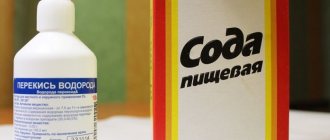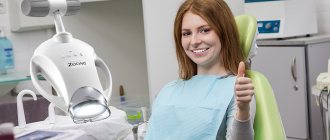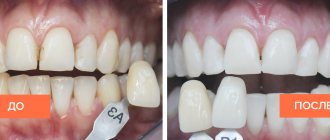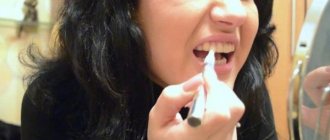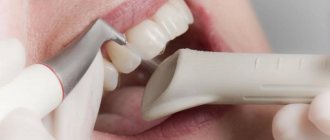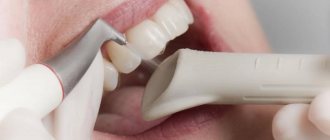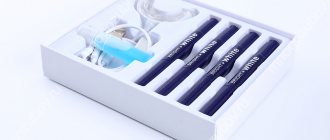Having a snow-white and attractive smile is not given to every person. And twenty years ago, for many this was a pipe dream. Today, all modern dental clinics offer a lot of ways to whiten teeth.
It is not always possible to use such clinic services, so many try to lighten the enamel at home, using accessible and inexpensive means, one of which is hydrogen peroxide.
What is it and how does it work
Hydrogen peroxide (chemical formula H2O2) is a colorless transparent liquid. In medicine it is used to treat damaged skin tissue. The product is a strong oxidizing agent and has a pronounced brightening property, which allows it to be used for enamel whitening.
When in contact with plaque on the enamel, active oxygen is released from the peroxide. Being a strong natural oxidizing agent, it penetrates deeply, oxidizes plaque from the inside and leads to decay. After several procedures, the enamel is lightened by removing impurities from its surface.
Such clarification without certain knowledge does not pass without a trace. If the product is used incorrectly, the protective layer of the teeth is destroyed.
How does it work?
Photo: patient’s enamel before (left) and after (right) using peroxide for lightening
Anyone can buy a solution of hydrogen peroxide at a regular pharmacy for a completely insignificant amount. It looks like a completely transparent liquid with no color. Its chemical formula is H2O2. Initially, it is needed to carry out the initial treatment of various skin lesions.
However, the properties of this compound suggest that it can also be used as a good bleach, which is often used at home. The fact is that peroxide is an excellent oxidizing agent
.
The chemical oxidation reaction that occurs when it comes into contact with the surface of the teeth causes the compound to break down into individual components and substances.
In the case of the product in question, so-called active oxygen is released
, which can act not only on the surface, but also in the inner layers of enamel close to it. It is this element that has the ability to break down organic substances that make teeth darker into ordinary water with carbon dioxide.
It should be noted that most medications intended for whitening contain hydrogen peroxide. These products include not only special pastes, but also complete systems for home whitening, available in the form of gels, trays or special strips.
In addition, professional techniques used in modern dental clinics involve the use of special preparations, which also include this chemical compound. However, nowhere is peroxide used on its own, only as part of preparations with many different additives.
Indications
The lightening procedure with the drug gives a good result in cases where a change in the tone of the enamel was caused by:
- natural aging;
- long-term use of tetracycline antibiotics;
- consumption of products containing dyes ;
- long history of smoking , addiction to strong tea and coffee;
- naturally grayish or yellowish enamel color;
- long-term use of fluoride-containing hygiene products.
Contraindications
Despite the fact that the product has proven itself as an effective bleach, it has several contraindications for use:
- pregnancy and lactation period;
- not recommended for children and adolescents under 16 years of age ;
- for systemic diseases such as asthma, hypertension, malignant neoplasms, endocrine disorders;
- the presence of crowns and fillings in the area of intended bleaching;
- presence of orthodontic systems (braces);
- with hyperesthesia (hypersensitivity) of enamel to low and high temperatures;
- intracavitary pathologies of the oral cavity and gums;
- thinning of enamel;
- for allergic reactions.
All these contraindications are an obstacle to the use of peroxide as both an independent bleaching agent and as part of care products.
About the benefits and harms of tooth powder, about the rules of use and much more. Click here to find out if thrush is contagious.
At this address https://dr-zubov.ru/ortodontiya/apparaty/plastiny/dlya-vyravnivaniya.html see photos of plates for straightening teeth.
Advantages
The use of peroxide has gained popularity over other methods for a number of advantages:
- accessible and inexpensive remedy;
- ease of use;
- achieving the desired result;
- there is no need to have special equipment and knowledge;
- simultaneously with bleaching, disinfection occurs, which reduces the likelihood of infection ;
- saving time, resources and money required to visit the dentist.
In-office bleaching
This term in dentistry means teeth whitening under the supervision of a doctor using gels based on hydrogen peroxide or urea, as well as catalysts in the form of ultraviolet light or a laser beam. The chemical composition affects only 20% of the organic substances contained in hard dental tissue (dentine) and does not cause any harm to the teeth. The final result of the procedure depends on the initial shade of the teeth, determined according to the VITA scale. In most cases, it is possible to achieve a lightening of 5 to 10 tones. Let's look at the features of each type of teeth whitening in the clinic.
Photobleaching
During photo-whitening, the whitening gel is applied to the tooth surface from the front. The action of the product is accelerated by a lamp with ultraviolet radiation. One session lasts 15 – 30 minutes. The maximum change in tooth shade is possible by 8 – 10 tones. The cost of the service is about 10,000 rubles.
Laser whitening
The reagent on the teeth is catalyzed by a laser beam rather than an ultraviolet lamp. Each tooth is processed separately. In one laser whitening procedure, you can improve your color by 12 shades. The price of an effective technique is proportionally high - from 20,000 rubles per session.
Chemical bleaching
In chemical whitening, a whitening gel is applied to the surface of the teeth, and no ultraviolet light or laser is used. The method is gentle, so teeth become whiter by only 5 to 7 tones. The cost of the procedure is about 12,000 rubles.
In-canal whitening
It is used when the tooth has darkened due to filling the canals with coloring materials. The dentist drills a hole in the tooth cavity, applies a brightening agent and places a temporary filling. After achieving the desired result, the final restoration of the tooth is carried out. Endo-whitening costs approximately 1,000 rubles per tooth.
Contrary to what many patients believe, the popular Air Flow procedure involves mechanical cleaning and not teeth whitening. A powerful stream of air, water, soda and other components removes bacterial and hard plaque, polishing and leveling the tooth surface. After the session, the teeth visually become whiter because they have been cleaned of impurities and returned to their natural color. The same can be said about ultrasonic whitening.
Possible complications
The use of the drug gives a good lightening result. But its incorrect and frequent use can lead to the development of unpleasant consequences, the most severe of which are the progressive destruction of tooth enamel and changes in the structure of the teeth.
This complication is explained by the ability of the components of the product to penetrate deeply into all layers of enamel and have a destructive effect on them.
Other problems may also appear.
Tooth hypersensitivity
A person experiences discomfort and even sharp pain when consuming cold or hot food or drinks. The cause of hypersensitivity lies in the thinning of the enamel.
This process is reversible. It will be enough to use a special gel or paste that will saturate the enamel tissue with minerals and block the reaction of nerve endings.
Chalked (re-whitened) teeth
Such a complication is rarely diagnosed and only in those who use peroxide in combination with baking soda for whitening for a long time. The initially shiny top layer wears off, revealing the inner layers.
The shine is lost, and the tooth itself looks like a coated surface. You will not be able to get rid of this condition on your own. Dentist assistance will be required.
All about laser teeth whitening and reviews from specialists and clients. See here photos of fluoridation of teeth in children.
Follow the link https://dr-zubov.ru/lechenie/chelyust/pochemu-shhelkaet-pri-otkrytii-rta.html to find out why your jaw may click.
Demineralization
The appearance of small whitish spots on the surface of the enamel, which gradually become more pronounced. Their formation indicates the loss of minerals necessary for teeth.
If appropriate measures are not taken in a timely manner, demineralization will lead to their destruction.
Today dentistry has a technique that allows you to stop the destruction process and enrich the enamel with lost minerals.
Irritation of the mucous membrane, burning, and changes in taste perception may also occur. But these complications are short-term and disappear after repeated thorough rinsing of the mouth.
Considering the consequences of such whitening, it is necessary to use this product with caution, after consulting a dentist.
A quick way to whiten your teeth
The development of dentistry has reached a high level and makes it possible to restore the whiteness of enamel quite quickly.
Toothpastes and rinses will allow you to achieve the desired result within a few weeks or months. Hydrogen peroxide-based preparations will make your smile radiant within a month with regular use.
Semi-professional home systems give results within a week with daily use. Today you can find products that promise to restore the whiteness of your enamel in one evening.
But the fastest and most effective are professional methods used by dentists. In one hour with a doctor, tooth enamel can be lightened by 8-12 shades at once, without any risk to health.
Are folk remedies effective in teeth whitening?
There are several folk methods that, even at the modern level of medical development, are quite actively used. All of them are available in price and method of application.
- Hydrogen peroxide. Sold in any pharmacy. Peroxide oxidizes the organic matrix under the enamel and thus brightens it. The essence of the method is as follows: after brushing your teeth, you need to treat the enamel surface with a 3% peroxide solution. This can be done with a clean napkin, cloth or cotton pad. This must be done extremely carefully, since if peroxide gets on the gums or mucous membranes, a burn may occur. This method cannot be used for a long time and often, since in addition to the coloring pigment, the top layer of enamel is also destroyed. Be extremely careful not to swallow the peroxide.
- Baking soda. Make a thick soda solution, apply it to the brush and brush your teeth as usual. You can add more salt to the solution. The procedure can be performed once a week.
- Tea tree oil. Perfectly restores and strengthens gums, reduces the amount of plaque. In the evening, after hygienic teeth cleaning, apply a few drops of oil to the brush and massage the teeth for several minutes. This method will maintain the white tint of the enamel. The procedure is recommended to be carried out 1-2 times a week.
Many people argue about the effectiveness of folk remedies for teeth whitening, but they do exist. Dentists are skeptical about such methods and recommend using special products.
List of recipes
To lighten enamel with peroxide at home, you can use several available recipes.
They will allow you to achieve good results without much time and money, subject to strict adherence to the execution technique.
Rinse
A simple recipe that does not require mixing several ingredients and preparing a special composition. The procedure takes place in 3 stages:
- Cleaning the enamel. It is performed with fluoride-containing paste in order to enrich teeth with fluoride, strengthen them and prevent destruction from the aggressive effects of peroxide.
- Rinsing. Peroxide is diluted with water in a 1:1 ratio. Its dilution 1:3 is allowed if the mucous membrane is tender and susceptible. The procedure takes no more than 1 minute. It is normal if, when rinsing, the peroxide begins to foam in the mouth - this is the result of a plaque splitting reaction.
- Cleansing the oral cavity from the presence of a bleaching agent. Thorough and repeated mouth rinsing with warm water is carried out.
Important: in order not to damage the stomach tissue, when rinsing, try not to swallow the product used.
Rinsing is carried out only once a day for a course of 2 weeks.
With added soda
Baking soda with hydrogen peroxide is a more effective and faster way to lighten.
These two components allow you to lighten the enamel simultaneously in two ways - the mechanical action of soda particles and the oxidative reaction provoked by peroxide.
Whitening is performed in the following order:
- Mix 1 tsp. 3% peroxide with 1 - 2 tsp. soda Mix the mixture well until you obtain a soft paste.
- Apply the paste onto the teeth with a cotton swab or finger so as not to touch the mucous membrane and soft tissue of the gums.
Important: do not use a toothbrush for application, as it will increase the aggressive effect and cause irritation.
- Leave the paste on your teeth for 2 - 3 minutes. All this time, gently rub the mixture over the surface of your teeth with your finger.
- Rinse with water and rinse your mouth several times.
- Brush your teeth with your usual toothpaste.
Lightening with this composition should be carried out once a day for a week.
Toothpaste enrichment method
It consists of enriching ordinary paste with hydrogen peroxide:
- Before you start brushing your teeth, add 2-3 drops of lemon juice and the same amount of peroxide to the regular toothpaste, the volume of which is required for a one-time procedure.
- All ingredients are mixed well until a homogeneous composition is obtained.
- Cleaning with the mixture lasts no more than 2 minutes.
Upon completion of the procedure, the oral cavity is cleaned with regular paste and rinsed several times with water. This is necessary to remove any remaining bleach. You can lighten the enamel with an enriched paste once a day in a course of a week.
These whitening methods are presented in order of increasing effect on teeth. Rinsing is less effective in terms of whitening, but it is also less aggressive on the enamel.
The latest recipe with an enriched paste allows you to lighten the enamel quite quickly, but it has an aggressive effect on the teeth and increases their sensitivity.
Watch the video for one of the recipes using hydrogen peroxide.
Whiten your teeth yourself
You can whiten your teeth at home without involving dentists in this process. Pharmacies have a huge selection of products that can completely whiten your teeth. The whole secret lies in hydrogen peroxide (or urea), which is an essential component of all whitening products.
Whitening gels, strips, and pencils are actively sold. Their use does not require special skills and they are very easy to apply. Such remedies act quite quickly. In addition, they are very convenient to use - you can take them to work or on a trip; You can go about your business and whiten your teeth at the same time. The results of gel products can be seen after just a few uses. The tone of the teeth can be lightened by 3-4 points, and the result usually lasts for a year.
The most popular brands of such products are Plus White, ROCS, Crest.
There are also at-home systems for teeth whitening. They are very similar to the technique used by dentists. The complex includes peroxide gel, mouthguard and activating lamp. With the help of such systems, teeth can be lightened by 4-5 tones, and the result lasts up to one and a half years. The most famous systems are Zoom, Opalescence.
Precautionary measures
Safe and effective whitening with peroxide can be achieved if you follow several recommendations when using it:
- Before starting the first procedure, it is important to test to ensure that you are not allergic to the product. To do this, simply apply a few drops of the product to your wrist and observe the reaction during the day. If redness appears on the skin, you should not bleach with peroxide.
- Using a solution with a concentration of more than 3% is fraught with burns to the mucous membrane , damage to the enamel and its subsequent destruction.
- If an unpleasant sensation, tingling or burning occurs, the use of peroxide should be stopped immediately and the mouth should be rinsed with water.
- It is important to use a fresh solution for bleaching. Long-term storage of an open bottle leads to a decrease in oxygen activity and loss of the brightening effect of the product.
- You should not perform the procedure if there are cracks, ulcers, or unhealed wounds in your mouth.
- Do not take any food or drinks (except clean water without gases) for 2 - 3 hours after lightening.
- In the first 3 - 4 days after lightening, the presence of foods with coloring substances in the diet is not recommended. It is also advisable to refrain from smoking.
- The course of procedures should not exceed 2 weeks.
Important: bleaching with peroxide should not be performed more than once a year.
If you decide to whiten your teeth with this product, you should visit a dentist. He will give the necessary recommendations on its use and determine the presence (absence) of contraindications. The next doctor's visit should be in 6 months.
Following these recommendations will help not only whiten your teeth safely and efficiently, but also maintain healthy enamel.
Types of professional teeth whitening
Reviews about types of teeth whitening on the Internet make many patients believe in the myth about the effectiveness of hydrogen peroxide purchased at the pharmacy, soda, activated carbon and other simple methods. Following such dubious advice is not only pointless, but also fraught with dangerous consequences - burns of the oral cavity, damage to the enamel and increased sensitivity of the teeth. In fact, there are only two types of professional whitening – in-office and at-home.
Efficiency
Using hydrogen peroxide as an enamel brightener at home allows you to change it by 1 - 2 tones. It is not worth continuing to use the product for stronger lightening, as this is dangerous for the development of serious complications.
The appearance of the result and its durability depend on the individual characteristics of the enamel and the reasons that caused its darkening. If the color change was caused by a love of coffee or tea, then the whitening result will be high and the process itself will be fast.
The situation is worse if the darkening is caused by age-related changes or addiction to smoking. In this case, in order to avoid injury to the enamel, gum tissue and mucous membrane, it is better to seek the services of a dentist.
What do they say about this method?
Many people use this method to achieve whiter teeth at home. Most of them who adhere to the recommendations get the desired effect.
If you are familiar with the methods described, you can provide feedback by adding a comment to this article.
Well, what do dentists say about home enamel whitening techniques? Let’s watch the following video:
If you find an error, please select a piece of text and press Ctrl+Enter.
Tags teeth whitening hydrogen peroxide
Did you like the article? stay tuned
Previous article
Oral sanitation: what is it, how is it done, cost
Next article
Tea tree oil for home teeth whitening

